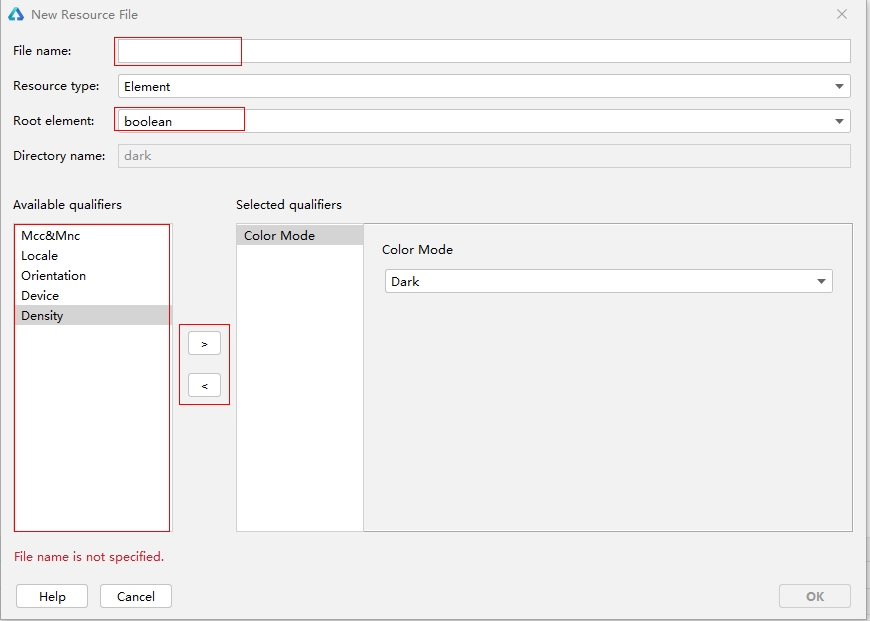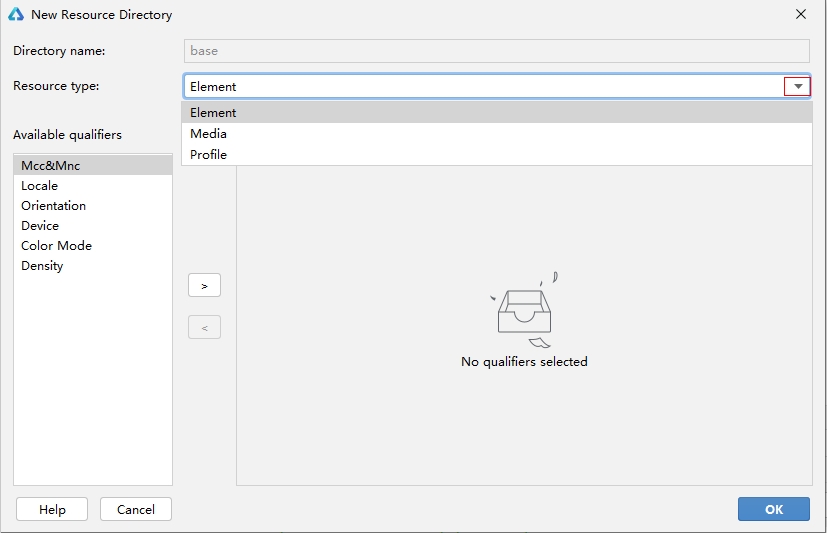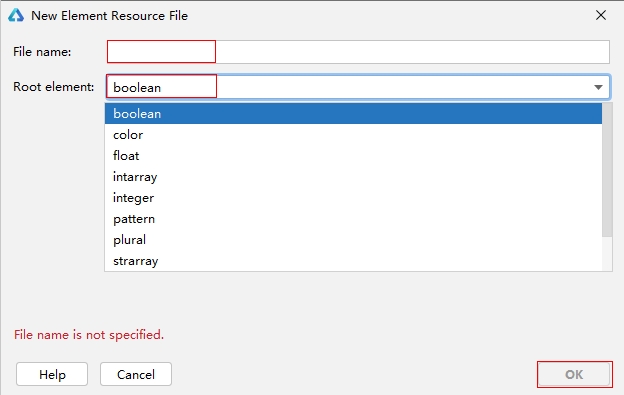Resource Categories and Access
During application development, you may need to use different resources, such as colors, fonts, spacing, and images, based on the device or configuration. Depending on the resource type, you can achieve this using the following methods:
-
Application resources: Configure device- or configuration-specific resources in the resource files.
-
System resources: Use the preset resource definitions (that is, layered parameters, with which a resource with the same ID has different values under different configurations, including device types and color modes).
Resource Categories
Resource files used during application development must be stored in specified directories for management. There are two types of resource directories, namely, resource directories and resource group directories. The resource directories are the base, qualifiers, and rawfile directories. The resource group directories are the element, media, and profile directories.
NOTE
The common resource files used across projects in the stage model are stored in the resources directory under AppScope.
Example of the resources directory:
resources
|---base
| |---element
| | |---string.json
| |---media
| | |---icon.png
| |---profile
| | |---test_profile.json
|---en_US // Default directory. When the device language is en-us, resources in this directory are preferentially matched.
| |---element
| | |---string.json
| |---media
| | |---icon.png
| |---profile
| | |---test_profile.json
|---zh_CN // Default directory. When the device language is zh-cn, resources in this directory are preferentially matched.
| |---element
| | |---string.json
| |---media
| | |---icon.png
| |---profile
| | |---test_profile.json
|---en_GB-vertical-car-mdpi // Example of a qualifiers directory, which needs to be created on your own.
| |---element
| | |---string.json
| |---media
| | |---icon.png
| |---profile
| | |---test_profile.json
|---rawfile // Other types of files are saved as raw files and will not be integrated into the resources.index file. You can customize the file name as needed.
Resource Directories
base Directory
The base directory is provided by default. Under this directory, the element subdirectory stores basic elements such as strings, colors, and boolean values, and the media and profile subdirectories store resource files such as media, animations, and layouts.
Resource files in the subdirectories are compiled into binary files, and each resource file is assigned an ID. Resource files in the subdirectory are referenced based on the resource type and resource name.
Qualifiers Directory
en_US and zh_CN are two default qualifiers directories. You need to create other qualifiers directories on your own. Under this directory, the subdirectories store basic elements such as strings, colors, and boolean values, as well as resource files such as media, animations, and layouts.
Resource files in the subdirectories are compiled into binary files, and each resource file is assigned an ID. Resource files in the subdirectories are referenced based on the resource type and resource name.
Naming Conventions for Qualifiers Directories
The name of a qualifiers directory consists of one or more qualifiers that represent the application scenarios or device characteristics, covering the mobile country code (MCC), mobile network code (MNC), language, script, country or region, screen orientation, device type, night mode, and screen density. The qualifiers are separated using underscores (_) or hyphens (-). Before creating a qualifiers directory, familiarize yourself with the directory naming conventions.
-
Qualifiers are ordered in the following sequence: _MCC_MNC-language_script_country/region-orientation-device-color mode-density_. You can select one or multiple qualifiers to name your subdirectory based on your application scenarios and device characteristics.
-
Separation between qualifiers: The language, script, and country/region qualifiers are separated using underscores (_); the MNC and MCC qualifiers are also separated using underscores (_); other qualifiers are separated using hyphens (-). For example, zh_Hant_CN and zh_CN-car-ldpi.
-
Value range of qualifiers: The value of each qualifier must meet the requirements specified in the following table. Otherwise, the resource files in the resources directory cannot be matched.
Table 2 Requirements for qualifier values
| Qualifier Type | Description and Value Range |
|---|---|
| MCC&MNC | Indicates the MCC and MNC, which are obtained from the network where the device is registered. The MCC can be either followed by the MNC with an underscore (_) in between or be used independently. For example, mcc460 represents China, and mcc460_mnc00 represents China Mobile. For details about the value range, refer to ITU-T E.212 (the international identification plan for public networks and subscriptions). |
| Language | Indicates the language used by the device. The value consists of two or three lowercase letters. For example, zh indicates Chinese, en indicates English, and mai indicates Maithili. For details about the value range, refer to ISO 639 (codes for the representation of names of languages). |
| Text | Indicates the script type used by the device. The value starts with one uppercase letter followed by three lowercase letters. For example, Hans indicates simplified Chinese, and Hant indicates traditional Chinese. For details about the value range, refer to ISO 15924 (codes for the representation of names of scripts). |
| Country/Region | Indicates the country or region where the user is located. The value consists of two or three uppercase letters or three digits. For example, CN indicates China, and GB indicates the United Kingdom. For details about the value range, refer to ISO 3166-1 (codes for the representation of names of countries and their subdivisions). |
| Screen orientation | Indicates the screen orientation of the device. The value can be: - vertical: portrait orientation - horizontal: landscape orientation |
| Device type | Indicates the device type. The value can be: - car: head unit - tablet: tablet - tv: smart TV - wearable: smart wearable |
| Color mode | Indicates the color mode of the device. The value can be: - dark: dark mode - light: light mode |
| Screen density | Indicates the screen density of the device, in dpi. The value can be: - sdpi: screen density with small-scale dots per inch (SDPI). This value is applicable for devices with a DPI range of (0, 120]. - mdpi: medium-scale screen density (Medium-scale Dots Per Inch), applicable to DPI whose value is (120, 160] device. - ldpi: screen density with large-scale dots per inch (LDPI). This value is applicable for devices with a DPI range of (160, 240]. - xldpi: screen density with extra-large-scale dots per inch (XLDPI). This value is applicable for devices with a DPI range of (240, 320]. - xxldpi: screen density with extra-extra-large-scale dots per inch (XXLDPI). This value is applicable for devices with a DPI range of (320, 480]. - xxxldpi: screen density with extra-extra-extra-large-scale dots per inch (XXXLDPI). This value is applicable for devices with a DPI range of (480, 640]. |
rawfile Directory
You can create multiple levels of subdirectories with custom names to store various resource files.
Resource files in the subdirectories are directly packed into the application without being compiled, and no IDs will be assigned to the resource files. The subdirectories are referenced based on the specified file path and file name.
Resource Group Directories
Resource group directories include element, media, and profile, which are used to store resource files of specific types.
Table 3 Resource group directories
| Directory | Description | Resource File |
|---|---|---|
| element | Element resources. Each type of data is represented by a JSON file. (Only files are supported in this directory.) The options are as follows: - boolean: boolean data - color: color data - float: floating-point data - intarray: array of integers - integer: integer data - pattern: pattern data - plural: plural form data - strarray: array of strings - string: string data |
It is recommended that files in the element subdirectory be named the same as the following files, each of which can contain only data of the same type: - boolean.json - color.json - float.json - intarray.json - integer.json - pattern.json - plural.json - strarray.json - string.json |
| media | Indicates media resources, including non-text files such as images, audios, and videos. (Only files are supported in this directory.) Table 4 and Table 5 describe the types of images, audios, and videos. |
The file name can be customized, for example, icon.png. |
| profile | Indicates a custom configuration file. You can obtain the file content by using the getProfileByAbility API. (Only files are supported in this directory.) | The file name can be customized, for example, test_profile.json. |
Media Resource Types
Table 4 Image resource types
| Format | File Name Extension |
|---|---|
| JPEG | .jpg |
| PNG | .png |
| GIF | .gif |
| SVG | .svg |
| WEBP | .webp |
| BMP | .bmp |
Table 5 Audio and video resource types
| Format | File Name Extension |
|---|---|
| H.263 | .3gp .mp4 |
| H.264 AVC Baseline Profile (BP) |
.3gp .mp4 |
| MPEG-4 SP | .3gp |
| VP8 | .webm .mkv |
Resource File Examples
The content of the color.json file is as follows:
{
"color": [
{
"name": "color_hello",
"value": "#ffff0000"
},
{
"name": "color_world",
"value": "#ff0000ff"
}
]
}
The content of the float.json file is as follows:
{
"float":[
{
"name":"font_hello",
"value":"28.0fp"
},
{
"name":"font_world",
"value":"20.0fp"
}
]
}
The content of the string.json file is as follows:
{
"string":[
{
"name":"string_hello",
"value":"Hello"
},
{
"name":"string_world",
"value":"World"
},
{
"name":"message_arrive",
"value":"We will arrive at %s."
}
]
}
The content of the plural.json file is as follows:
{
"plural":[
{
"name":"eat_apple",
"value":[
{
"quantity":"one",
"value":"%d apple"
},
{
"quantity":"other",
"value":"%d apples"
}
]
}
]
}
Creating a Resource Directory and Resource File
You can create a directory and its files under the resources directory based on the preceding descriptions of the qualifiers directories and resource group directories. DevEco Studio provides a wizard for you to create resource directories and resource files.
Creating a Resource Directory and Resource File
Right-click the resources directory and choose New > Resource File. If no qualifier is selected, the file is created in a resource group directory under base. If one or more qualifiers are selected, the system automatically generates a subdirectory and creates the file in this subdirectory.
In File name, enter the name of the resource file to create. In Resource type, select the type of the resource group, which is element by default. In Root Element, select a resource type. To select a qualifier, highlight it under Available qualifiers and click the right arrow. To deselect a qualifier, highlight it under Selected qualifiers and click the left arrow.
The created directory is automatically named in the format of Qualifiers.Resource group type. For example, if you create a subdirectory by setting Color Mode to Dark and Resource type to Element, the system automatically generates a subdirectory named dark.element.

Creating a Resource Directory
Right-click the resources directory and choose New > Resource Directory to create a directory only. By default, the base directory is created. You can create qualifiers directories as required, by specifying the qualifier and resource group type.

Creating a Resource File
Right-click a directory under resources and choose New > XXX Resource File. This operation creates a resource file under this directory. For example, you can create an element resource file in the element subdirectory.

Resource Access
Application Resources
-
To reference an application resource in a project, use the "$r('app.type.name')" format. app indicates the resource defined in the resources directory of the application. type indicates the resource type (or the location where the resource is stored). The value can be color, float, string, plural, or media. name indicates the resource name, which you set when defining the resource.
-
When referencing resources in the rawfile subdirectory, use the "$rawfile('filename')" format. Wherein filename indicates the relative path of a file in the rawfile subdirectory, which must contain the file name extension and cannot start with a slash (/).
-
To obtain the descriptor of a file in the rawfile subdirectory, you can use the getRawFd API, whose return value descriptor.fd is the file descriptor (FD). To access the file with this FD, use {fd, offset, length}.
NOTE
Resource descriptors accept only strings, such as 'app.type.name', and cannot be combined.
The return value of $r is a Resource object. You can obtain the corresponding string by using the getStringValue API.
As described in Resource Group Directories, you can reference .json resource files, including color.json, string.json, and** plural.json**.
The usage is as follows:
Text($r('app.string.string_hello'))
.fontColor($r('app.color.color_hello'))
.fontSize($r('app.float.font_hello'))
Text($r('app.string.string_world'))
.fontColor($r('app.color.color_world'))
.fontSize($r('app.float.font_world'))
// Reference string resources. The first parameter of $r indicates the string resource, and the second parameter is used to replace %s in the string.json file.
// In this example, the resultant value is "We will arrive at five of the clock".
Text($r('app.string.message_arrive', "five of the clock"))
.fontColor($r('app.color.color_hello'))
.fontSize($r('app.float.font_hello'))
// Reference plural resources. The first parameter of $r indicates the plural resource, the second parameter indicates the number of plural resources (for English, one indicates singular and is represented by 1, and other indicates plural and is represented by an integer greater than or equal to 1; for Chinese, other indicates both singular and plural), and the third parameter is used to replace %d.
// In this example, the resultant value is "5 apples".
Text($r('app.plural.eat_apple', 5, 5))
.fontColor($r('app.color.color_world'))
.fontSize($r('app.float.font_world'))
Image($r('app.media.my_background_image')) // Reference media resources.
Image($rawfile('test.png')) // Reference an image in the rawfile directory.
Image($rawfile('newDir/newTest.png')) // Reference an image in the rawfile directory.
System Resources
Apart from custom resources, you can use system resources to develop different applications with the same visual style. For details about the system resource IDs and their values in different configurations, see Resources.
During development, the usage of layered parameters is basically the same as that of qualifiers. To reference a system resource, use the "$r('sys.type.resource_id')" format. Wherein: sys indicates a system resource; type indicates the resource type, which can be color, float, string, or media; resource_id indicates the resource ID.
NOTE
The use of system resources is only supported in the declarative development paradigm.
For preset applications, you are advised to use system resources. For third-party applications, you can choose to use system resources or custom application resources as required.
Text('Hello')
.fontColor($r('sys.color.ohos_id_color_emphasize'))
.fontSize($r('sys.float.ohos_id_text_size_headline1'))
.fontFamily($r('sys.string.ohos_id_text_font_family_medium'))
.backgroundColor($r('sys.color.ohos_id_color_palette_aux1'))
Image($r('sys.media.ohos_app_icon'))
.border({
color: $r('sys.color.ohos_id_color_palette_aux1'),
radius: $r('sys.float.ohos_id_corner_radius_button'), width: 2
})
.margin({
top: $r('sys.float.ohos_id_elements_margin_horizontal_m'),
bottom: $r('sys.float.ohos_id_elements_margin_horizontal_l')
})
.height(200)
.width(300)
Resource Matching
When your application needs to use a resource, the system preferentially searches the qualifiers subdirectories that match the current device state. The system searches the base subdirectory for the target resource only when the resources directory does not contain any qualifiers subdirectories that match the current device state or the target resource is not found in the qualifiers subdirectories. The rawfile directory is not searched for resources.
Rules for Matching Qualifiers Subdirectories and Device Resources
-
Qualifiers are matched with the device resources in the following priorities: MCC&MNC > locale (options: language, language_script, language_country/region, and language_script_country/region) > screen orientation > device type > color mode > screen density
-
If the qualifiers subdirectories contain the MCC, MNC, language, script, screen orientation, device type, and color mode qualifiers, their values must be consistent with the current device status so that the subdirectories can be used for matching the device resources. For example, the qualifiers subdirectory zh_CN-car-ldpi cannot be used for matching the resource files labeled en_US.
For more information about how resources are loaded in applications, see the internationalization and localization documents.
Overlay Mechanism
Overylay is a resource replacement mechanism. With overlay resource packages, you enable your application GUI to adapt to different styles of various brands and products, without having to repack your application HAPs. The overylay mechanism works in dynamic and static modes.
- Using overlay in dynamic mode
-
Place the overlay resource package in the target application installation path. For example, for the com.example.overlay application, place the overlay resource package in data/app/el1/bundle/public/com.example.overlay/.
-
The application uses addResource(path) to load overlay resources and uses removeResource(path) to remove overlay resources. The path to an overlay resource consists of the application's sandbox root directory (obtained through getContext().BundleCodeDir) and the HSP name of the resource. For example, let path = getContext().bundleCodeDir + "HSP name", such as /data/storage/el1/bundle/enter-release-signed.hsp.
- Using overlay in static mode
If the module.json5 file of a module contains the targetModuleName and targetPriority fields during project creation on DevEco Studio, the module is identified as a module with the overlay feature in the installation phase. Modules with the overlay feature generally provide an overlay resource file for other modules on the device, so that the module specified by targetModuleName can display different colors, labels, themes, and the like by using the overlay resource file in a running phase.
The overlay feature is enabled by default. For details about how to enable and disable this feature, see @ohos.bundle.overlay (overlay).